Mechanisms of Enhanced Thermal Durability in Porosity-Controlled Multilayer Thermal Barrier Coatings
Abstract
1. Introduction
2. Experimental Procedure
2.1. Sample Preparation
2.2. Characterizations and Thermal Durability Tests
3. Results and Discussion
3.1. Analysis of Powders and Fabricated TBC Specimens
3.2. Enhancement of Thermal Durability Through Multilayer Structure and Porosity Control
3.3. Analysis of Mechanisms for Enhanced Thermal Durability
4. Conclusions
- Employing porosity-controlled multilayer TBCs improved thermal durability by up to 50% compared to single-layer coatings, especially with a high-density layer within 200 µm.
- Analysis of the stress distribution during thermal cycling provided insights into the delamination mechanisms occurring in both high- and low-density YSZ layers.
- Optimizing high-density layer thickness to regulate residual stresses and prevent catastrophic delamination is crucial for achieving high thermal durability in multilayer TBCs.
- Owing to the residual YSZ layer, better thermal durability and minimal substrate damage can be achieved during high-temperature repairs, offering a promising way to extend the lifespan of hot components.
Author Contributions
Funding
Institutional Review Board Statement
Informed Consent Statement
Data Availability Statement
Conflicts of Interest
References
- Padture, N.P.; Gell, M.; Jordan, E.H. Thermal barrier coatings for gas-turbine engine applications. Science 2002, 296, 280–284. [Google Scholar] [CrossRef] [PubMed]
- Bakan, E.; Mack, D.E.; Mauer, G.; Vaßen, R.; Lamon, J.; Padture, N.P. High-temperature materials for power generation in gas turbines. In Advanced Ceramics for Energy Conversion and Storage; Elsevier: Amsterdam, The Netherlands, 2020; pp. 3–62. [Google Scholar]
- Poullikkas, A. An overview of current and future sustainable gas turbine technologies. Renew. Sustain. Energy Rev. 2005, 9, 409–443. [Google Scholar] [CrossRef]
- MacIsaac, B.; Langton, R.; Belobaba, P.; Cooper, J.; Seabridge, A. Gas Turbine Propulsion Systems; John Wiley & Sons: Hoboken, NJ, USA, 2011. [Google Scholar]
- Soares, C. Gas Turbines: A Handbook of Air, Land And Sea Applications; Elsevier: Amsterdam, The Netherlands, 2011. [Google Scholar]
- Huda, Z.; Zaharinie, T.; Al-Ansary, H.A. Enhancing power output and profitability through energy-efficiency techniques and advanced materials in today’s industrial gas turbines. Int. J. Mech. Mater. Eng. 2014, 9, 2. [Google Scholar] [CrossRef]
- Smith, R.W.; Gülen, S.C. Natural gas power. In Fossil Energy; Springer: New York, NY, USA, 2020; pp. 249–307. [Google Scholar]
- Hetmańczyk, M.; Swadźba, L.; Mendala, B. Advanced materials and protective coatings in aero-engines application. J. Achiev. Mater. Manuf. Eng. 2007, 24, 372–381. [Google Scholar]
- Alvin, M.A.; Klotz, K.; McMordie, B.; Zhu, D.; Gleeson, B.; Warnes, B. Extreme temperature coatings for future gas turbine engines. J. Eng. Gas Turbines Power 2014, 136, 112102. [Google Scholar] [CrossRef]
- Troy, N.; Denny, E.; O’Malley, M. Base-load cycling on a system with significant wind penetration. IEEE Trans. Power Syst. 2010, 25, 1088–1097. [Google Scholar] [CrossRef]
- Farhat, H.; Salvini, C. Novel gas turbine challenges to support the clean energy transition. Energies 2022, 15, 5474. [Google Scholar] [CrossRef]
- Viswanathan, R. Damage Mechanisms and Life Assessment of High Temperature Components; ASM International: Almere, The Netherlands, 1989. [Google Scholar]
- Sequeira, C.A. High Temperature Corrosion: Fundamentals and Engineering; John Wiley & Sons: Hoboken, NJ, USA, 2019. [Google Scholar]
- Song, D.; Song, T.; Paik, U.; Lyu, G.; Kim, J.; Jung, Y. Improvement in hot corrosion resistance and chemical stability of YSZ by introducing a Lewis neutral layer on thermal barrier coatings. Corros. Sci. 2020, 173, 108776. [Google Scholar] [CrossRef]
- Bakan, E.; Vaßen, R. Ceramic top coats of plasma-sprayed thermal barrier coatings: Materials, processes, and properties. J. Therm. Spray Technol. 2017, 26, 992–1010. [Google Scholar] [CrossRef]
- Zhao, H.; Yu, F.; Bennett, T.D.; Wadley, H.N. Morphology and thermal conductivity of yttria-stabilized zirconia coatings. Acta Mater. 2006, 54, 5195–5207. [Google Scholar] [CrossRef]
- Pakseresht, A.; Sharifianjazi, F.; Esmaeilkhanian, A.; Bazli, L.; Nafchi, M.R.; Bazli, M.; Kirubaharan, K. Failure mechanisms and structure tailoring of YSZ and new candidates for thermal barrier coatings: A systematic review. Mater. Des. 2022, 222, 111044. [Google Scholar] [CrossRef]
- Mehta, A.; Vasudev, H.; Singh, S.; Prakash, C.; Saxena, K.K.; Linul, E.; Buddhi, D.; Xu, J. Processing and advancements in the development of thermal barrier coatings: A review. Coatings 2022, 12, 1318. [Google Scholar] [CrossRef]
- Kumar, V.; Balasubramanian, K. Progress update on failure mechanisms of advanced thermal barrier coatings: A review. Prog. Org. Coat. 2016, 90, 54–82. [Google Scholar] [CrossRef]
- Cheng, B.; Yang, N.; Zhang, Q.; Zhang, Y.; Chen, L.; Yang, G.; Li, C.; Li, C. Sintering induced the failure behavior of dense vertically crack and lamellar structured TBCs with equivalent thermal insulation performance. Ceram Int. 2017, 43, 15459–15465. [Google Scholar] [CrossRef]
- Chen, X.; Ohnuki, T.; Kuroda, S.; Gizynski, M.; Araki, H.; Murakami, H.; Watanabe, M.; Sakka, Y. Columnar and DVC-structured thermal barrier coatings deposited by suspension plasma spray: High-temperature stability and their corrosion resistance to the molten salt. Ceram Int. 2016, 42, 16822–16832. [Google Scholar] [CrossRef]
- Lu, Z.; Myoung, S.; Kim, H.; Kim, M.; Lee, J.; Jung, Y.; Jang, J.; Paik, U. Microstructure evolution and interface stability of thermal barrier coatings with vertical type cracks in cyclic thermal exposure. J. Therm. Spray Technol. 2013, 22, 671–679. [Google Scholar] [CrossRef]
- Jung, S.; Kim, J.; Lee, J.; Jung, Y.; Paik, U.; Lee, K. Microstructure and mechanical properties of zirconia-based thermal barrier coatings with starting powder morphology. Surf. Coat. Technol. 2009, 204, 802–806. [Google Scholar] [CrossRef]
- Stöver, D.; Pracht, G.; Lehmann, H.; Dietrich, M.; Döring, J.-E.; Vaßen, R. New material concepts for the next generation of plasma-sprayed thermal barrier coatings. J. Therm. Spray Technol. 2004, 13, 76–83. [Google Scholar] [CrossRef]
- Lashmi, P.G.; Ananthapadmanabhan, P.V.; Unnikrishnan, G.; Aruna, S.T. Present status and future prospects of plasma sprayed multilayered thermal barrier coating systems. J. Eur. Ceram. Soc. 2020, 40, 2731–2745. [Google Scholar] [CrossRef]
- Song, D.; Paik, U.; Guo, X.; Zhang, J.; Woo, T.; Lu, Z.; Jung, S.; Lee, J.; Jung, Y. Microstructure design for blended feedstock and its thermal durability in lanthanum zirconate based thermal barrier coatings. Surf. Coat. Technol. 2016, 308, 40–49. [Google Scholar] [CrossRef]
- Huang, J.B.; Wang, W.Z.; Li, Y.J.; Fang, H.J.; Ye, D.D.; Zhang, X.C.; Tu, S.T. A novel strategy to control the microstructure of plasma-sprayed YSZ thermal barrier coatings. Surf. Coat. Technol. 2020, 402, 126304. [Google Scholar] [CrossRef]
- Krishnasamy, J.; Ponnusami, S.A.; Turteltaub, S.; van der Zwaag, S. Computational investigation of porosity effects on fracture behavior of thermal barrier coatings. Ceram Int. 2019, 45, 20518–20527. [Google Scholar] [CrossRef]
- Man, Y.; Hua, C.; Huang, T.; Yin, G.; Ma, T.; Zhuang, Y.; He, X.; Xiong, X. Positive effect of large porosity in super-thick thermal barrier coatings on thermal shock resistance and failure mechanisms. J. Alloys Compd. 2025, 1017, 178792. [Google Scholar] [CrossRef]
- Nouri, A.; Sola, A. Powder morphology in thermal spraying. J. Adv. Manuf. Process. 2019, 1, e10020. [Google Scholar] [CrossRef]
- Qadir, D.; Sharif, R.; Nasir, R.; Awad, A.; Mannan, H.A. A review on coatings through thermal spraying. Chem. Pap. 2024, 78, 71–91. [Google Scholar] [CrossRef]
- Guo, H.B.; Murakami, H.; Kuroda, S. Effect of hollow spherical powder size distribution on porosity and segmentation cracks in thermal barrier coatings. J. Am. Ceram. Soc. 2006, 89, 3797–3804. [Google Scholar] [CrossRef]
- Cao, X.Q.; Vassen, R.; Schwartz, S.; Jungen, W.; Tietz, F.; Stöever, D. Spray-drying of ceramics for plasma-spray coating. J. Eur. Ceram. Soc. 2000, 20, 2433–2439. [Google Scholar] [CrossRef]
- Izadinia, M.; Soltani, R.; Sohi, M.H. Formation of vertical cracks in air plasma sprayed YSZ coatings using unpyrolyzed powder. Ceram. Int. 2020, 46, 22383–22390. [Google Scholar] [CrossRef]
- Bursich, S.; Morelli, S.; Bolelli, G.; Cavazzini, G.; Rossi, E.; Mecca, F.G.; Petruzzi, S.; Bemporad, E.; Lusvarghi, L. The effect of ceramic YSZ powder morphology on coating performance for industrial TBCs. Surf. Coat. Technol. 2024, 476, 130270. [Google Scholar] [CrossRef]
- Sobhanverdi, R.; Akbari, A. Porosity and microstructural features of plasma sprayed Yttria stabilized Zirconia thermal barrier coatings. Ceram. Int. 2015, 41, 14517–14528. [Google Scholar] [CrossRef]
- Karger, M.; Vaßen, R.; Stöver, D. Atmospheric plasma sprayed thermal barrier coatings with high segmentation crack densities: Spraying process, microstructure and thermal cycling behavior. Surf. Coat. Technol. 2011, 206, 16–23. [Google Scholar] [CrossRef]
- Li, Y.; Huang, J.; Wang, W.; Ye, D.; Fang, H.; Gao, D.; Tu, S.; Guo, X.; Yu, Z. Control of the pore structure of plasma-sprayed thermal barrier coatings through the addition of unmelted porous YSZ particles. Coatings 2021, 11, 360. [Google Scholar] [CrossRef]
- Huang, J.B.; Wang, W.Z.; Li, Y.J.; Fang, H.J.; Ye, D.D.; Zhang, X.C.; Tu, S.T. Novel-structured plasma-sprayed thermal barrier coatings with low thermal conductivity, high sintering resistance and high durability. Ceram. Int. 2021, 47, 5156–5167. [Google Scholar] [CrossRef]
- Moskal, G. Thermal barrier coatings: Characteristics of microstructure and properties, generation and directions of development of bond. J. Achiev. Mater. Manuf. Eng. 2009, 37, 323–331. [Google Scholar]
- Huang, J.; Wang, W.; Li, Y.; Fang, H.; Ye, D.; Zhang, X.; Tu, S. Improve durability of plasma-splayed thermal barrier coatings by decreasing sintering-induced stiffening in ceramic coatings. J. Eur. Ceram. Soc. 2020, 40, 1433–1442. [Google Scholar] [CrossRef]
- Chen, W.R.; Wu, X.; Marple, B.R.; Nagy, D.R.; Patnaik, P.C. TGO growth behaviour in TBCs with APS and HVOF bond coats. Surf. Coat. Technol. 2008, 202, 2677–2683. [Google Scholar] [CrossRef]
- Daroonparvar, M.; Hussain, M.S.; Yajid, M.A.M. The role of formation of continues thermally grown oxide layer on the nanostructured NiCrAlY bond coat during thermal exposure in air. Appl. Surf. Sci. 2012, 261, 287–297. [Google Scholar] [CrossRef]
- Bumgardner, C.; Croom, B.; Li, X. High-temperature delamination mechanisms of thermal barrier coatings: In-situ digital image correlation and finite element analyses. Acta Mater. 2017, 128, 54–63. [Google Scholar] [CrossRef]
- Dong, H.; Yang, G.; Li, C.; Luo, X.; Li, C. Effect of TGO thickness on thermal cyclic lifetime and failure mode of plasma-sprayed TBC s. J. Am. Ceram. Soc. 2014, 97, 1226–1232. [Google Scholar] [CrossRef]
- Song, X.; Meng, F.; Kong, M.; Wang, Y.; Huang, L.; Zheng, X.; Zeng, Y. Thickness and microstructure characterization of TGO in thermal barrier coatings by 3D reconstruction. Mater. Charact. 2016, 120, 244–248. [Google Scholar] [CrossRef]
- Torkashvand, K.; Poursaeidi, E.; Mohammadi, M. Effect of TGO thickness on the thermal barrier coatings life under thermal shock and thermal cycle loading. Ceram. Int. 2018, 44, 9283–9293. [Google Scholar] [CrossRef]
- Cui, S.; Liang, W.; Mora, L.S.; Miao, Q.; Domblesky, J.P.; Lin, H.; Yu, L. Mechanical analysis and modeling of porous thermal barrier coatings. Appl. Surf. Sci. 2020, 512, 145706. [Google Scholar] [CrossRef]
- Liu, K.; Du, Y.; Guo, X.; Ma, J.; He, W.; Cao, Y.; Du, J. Study of stress-driven cracking behavior and competitive crack growth in functionally graded thermal barrier coatings. Surf. Coat. Technol. 2023, 473, 129969. [Google Scholar] [CrossRef]
- Liu, D.; Kyaw, S.T.; Flewitt, P.; Seraffon, M.; Simms, N.J.; Pavier, M.; Jones, I.A. Residual stresses in environmental and thermal barrier coatings on curved superalloy substrates: Experimental measurements and modelling. Mater. Sci. Eng. A 2014, 606, 117–126. [Google Scholar] [CrossRef]
- Shen, Q.; Yang, L.; Zhou, Y.C.; Wei, Y.G.; Zhu, W. Effects of growth stress in finite-deformation thermally grown oxide on failure mechanism of thermal barrier coatings. Mech. Mater. 2017, 114, 228–242. [Google Scholar] [CrossRef]
- Qian, G.; Nakamura, T.; Berndt, C.C. Effects of thermal gradient and residual stresses on thermal barrier coating fracture. Mech. Mater. 1998, 27, 91–110. [Google Scholar] [CrossRef]
- Yang, D.; Gao, Y.; Liu, H.; Sun, C. Thermal shock resistance of bimodal structured thermal barrier coatings by atmospheric plasma spraying using nanostructured partially stabilized zirconia. Surf. Coat. Technol. 2017, 315, 9–16. [Google Scholar] [CrossRef]
- Wang, Y.; Wang, C.; You, Y.; Cheng, W.; Dong, M.; Zhu, Z.; Liu, J.; Wang, L.; Zhang, X.; Wang, Y. Thermal stress analysis of optimized functionally graded coatings during crack propagation based on finite element simulation. Surf. Coat. Technol. 2023, 463, 129535. [Google Scholar] [CrossRef]
- Li, C.; Zhang, X.; Chen, Y.; Carr, J.; Jacques, S.; Behnsen, J.; Di Michiel, M.; Xiao, P.; Cernik, R. Understanding the residual stress distribution through the thickness of atmosphere plasma sprayed (APS) thermal barrier coatings (TBCs) by high energy synchrotron XRD; digital image correlation (DIC) and image based modelling. Acta Mater. 2017, 132, 1–12. [Google Scholar] [CrossRef]
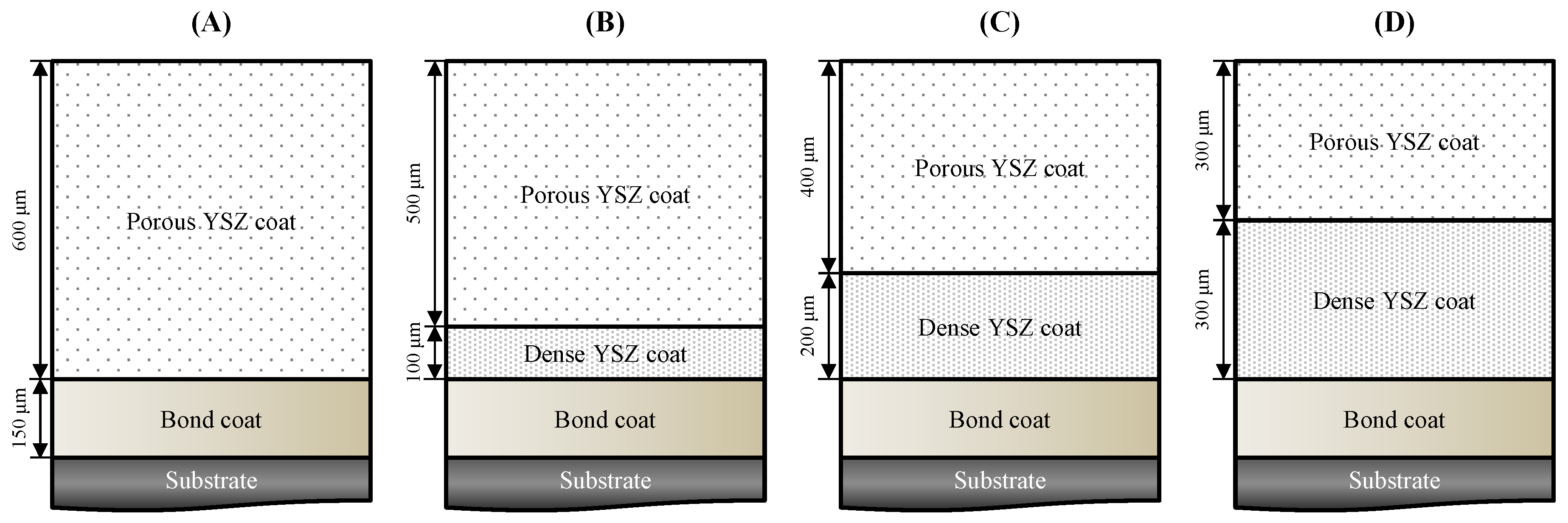
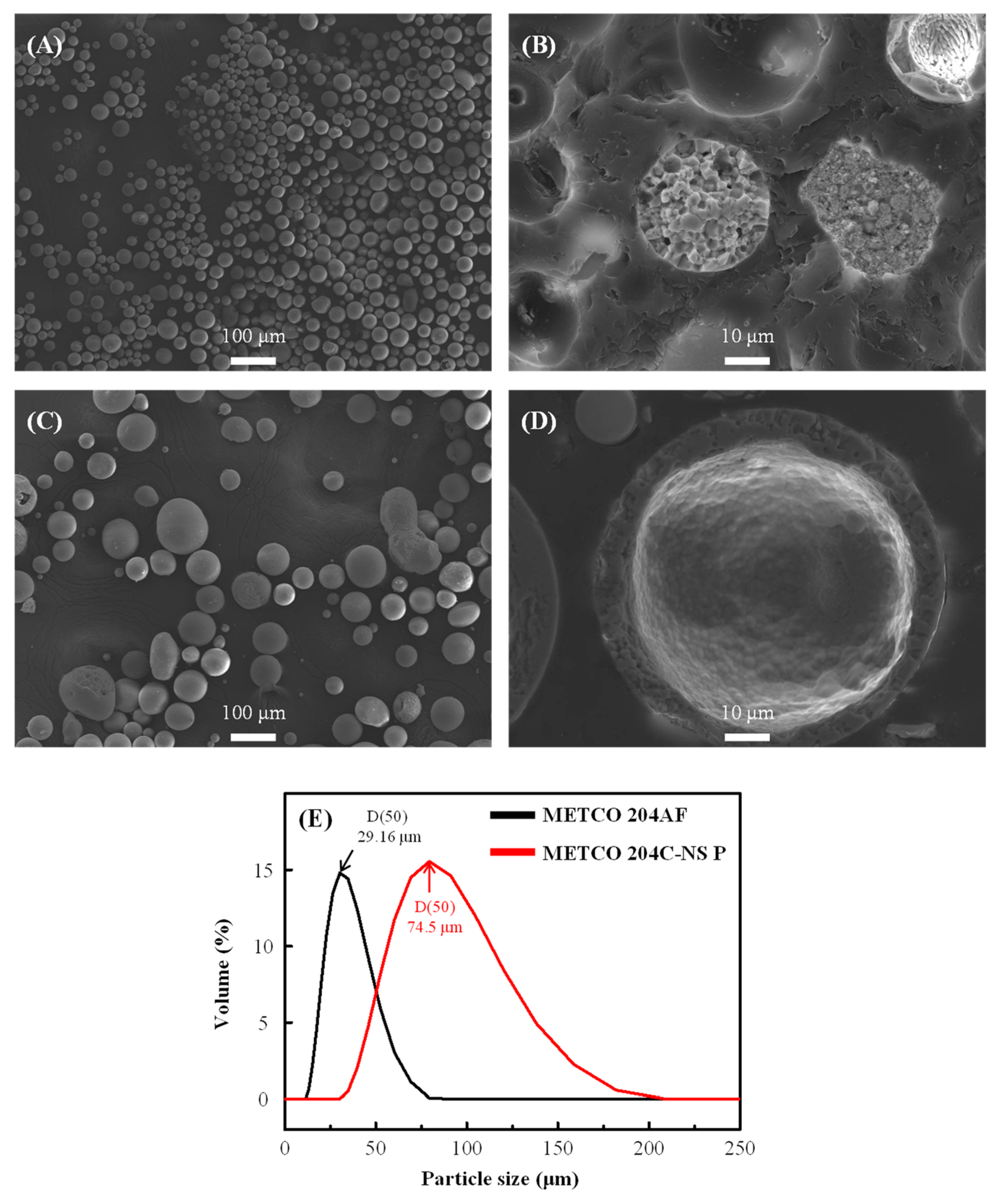
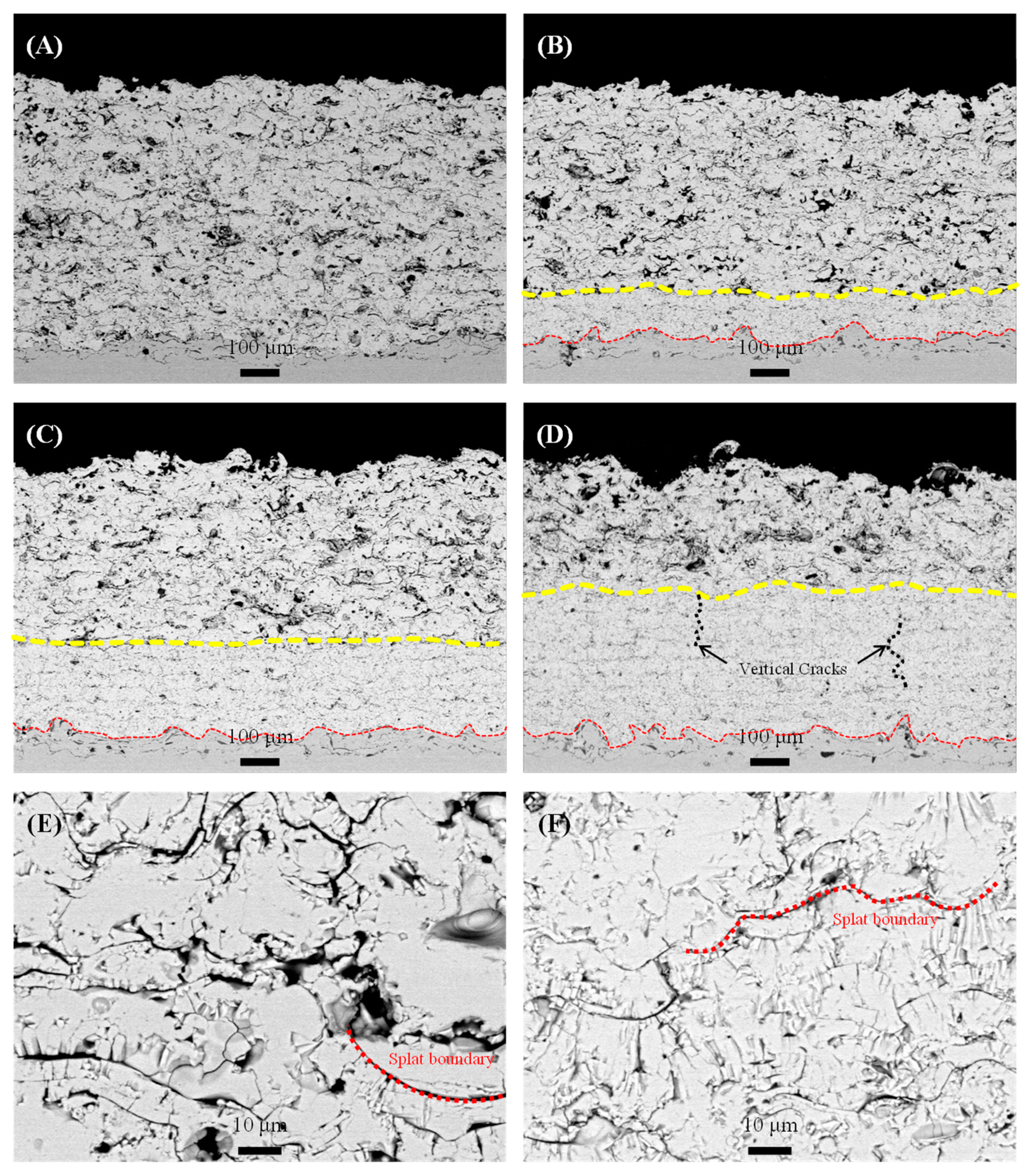
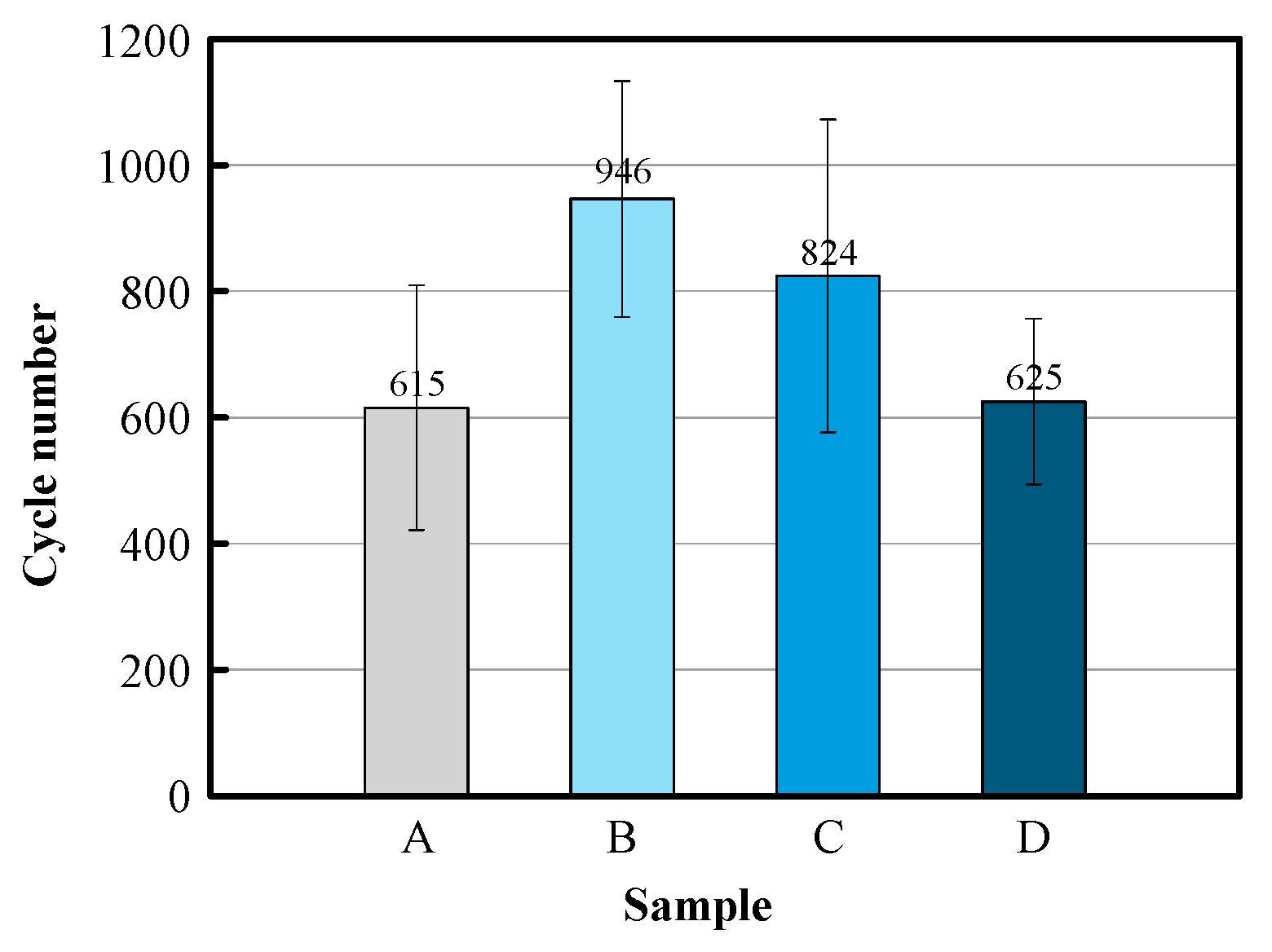
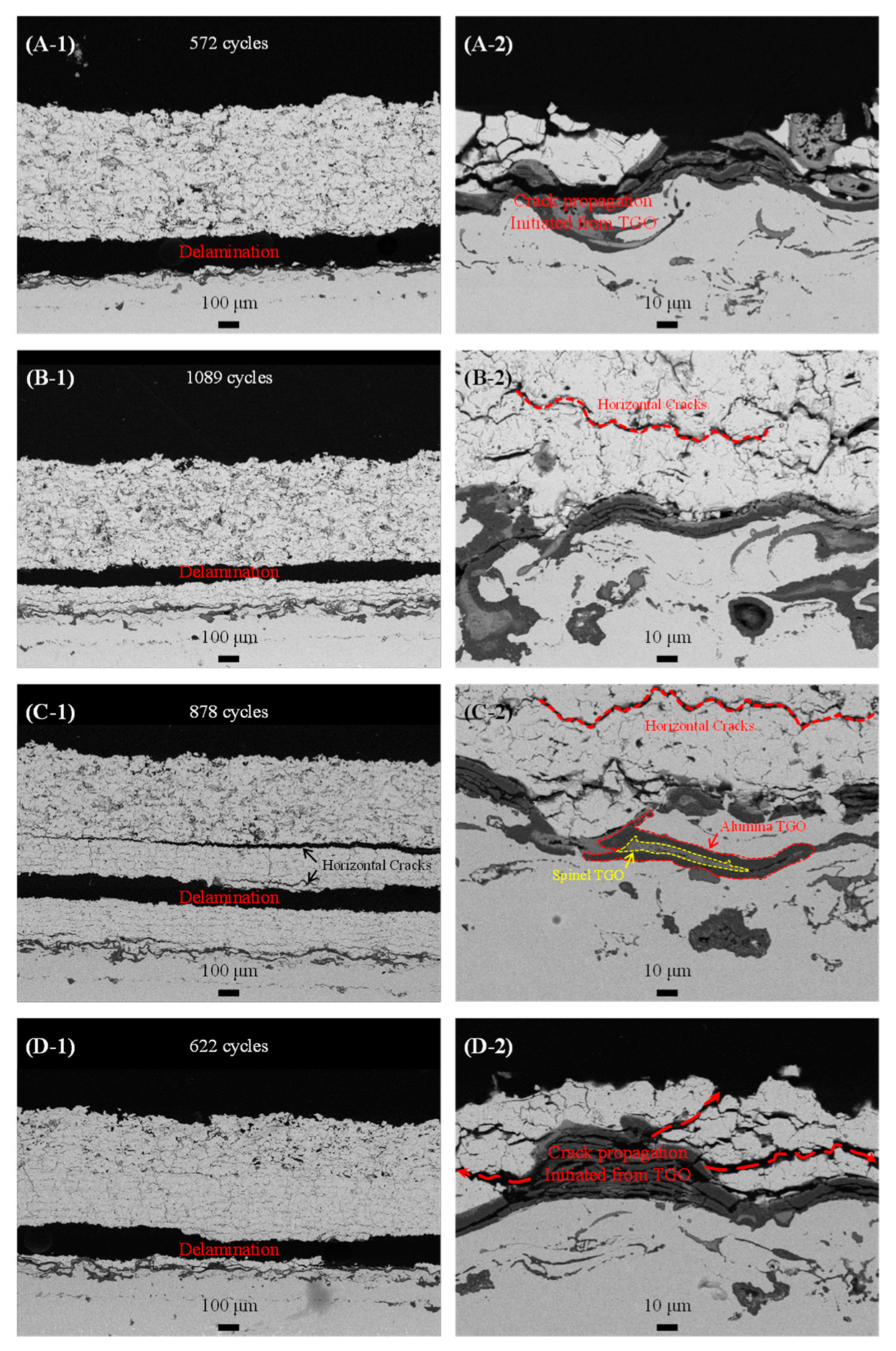
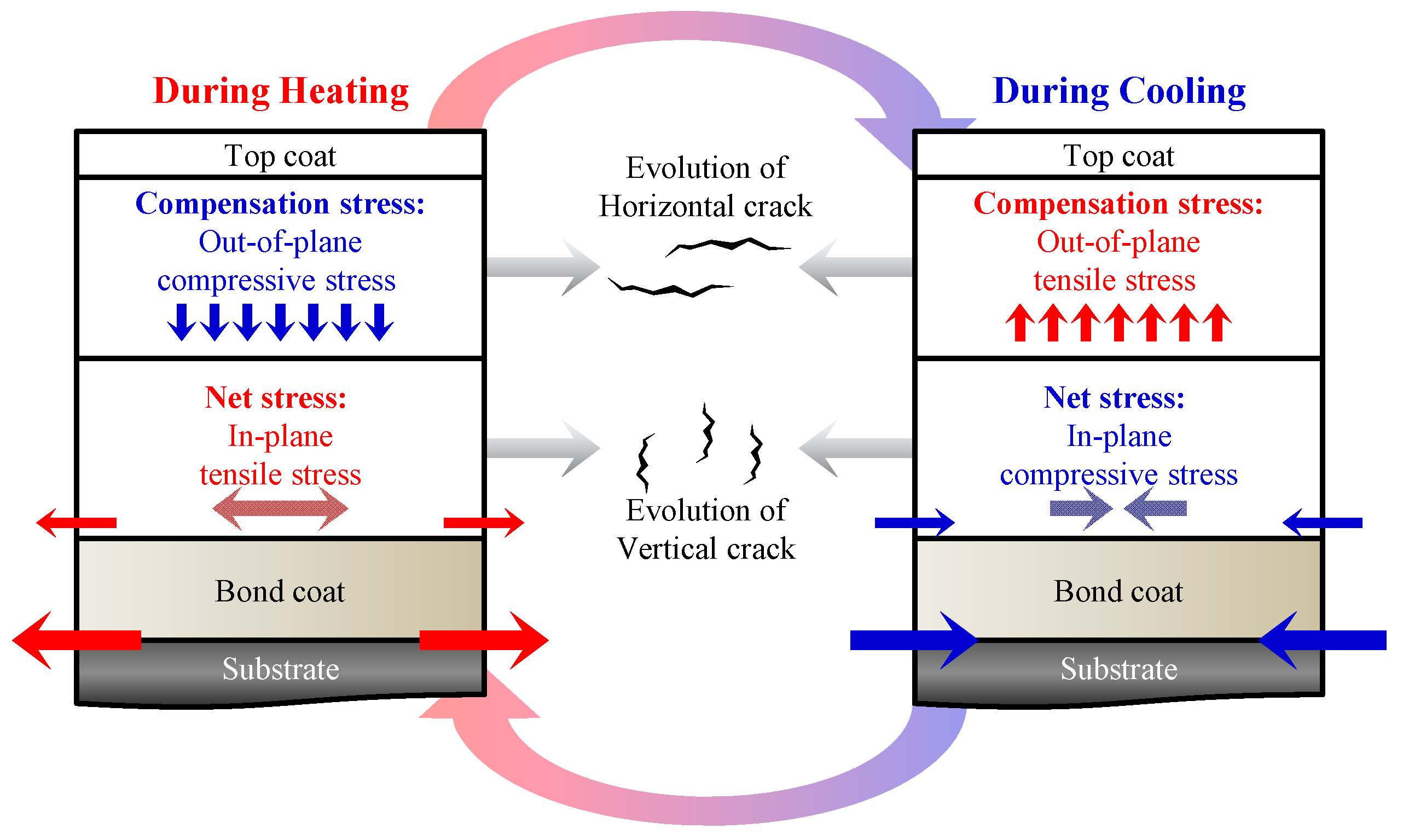
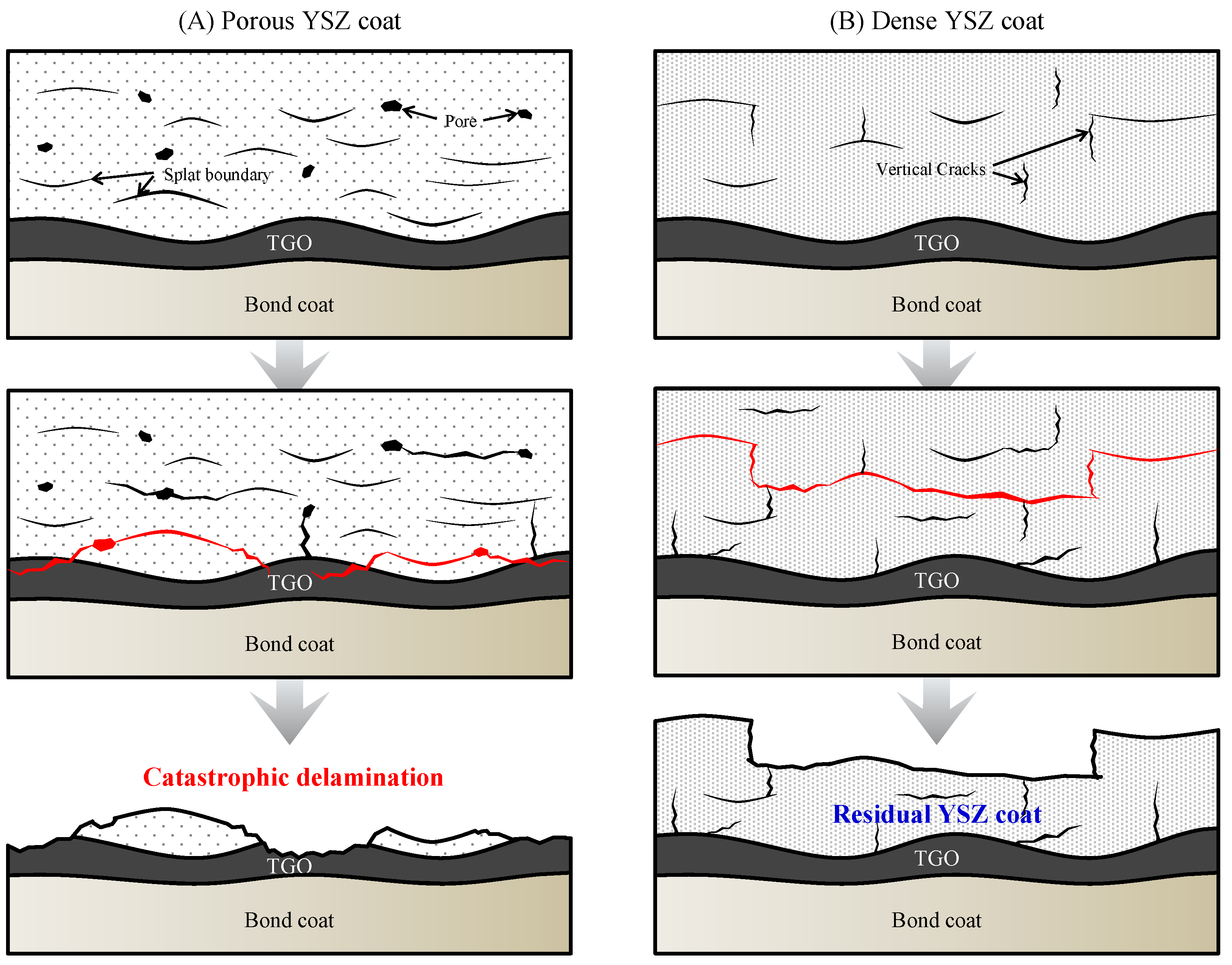
| Item | Gun | Feeding Rate | Gun Distance | Gun Speed | Step Distance | Carrier Gas | Flow Rate |
|---|---|---|---|---|---|---|---|
| Bond coat (HVOF) | DJ2600 | 60 ± 1 g/min | 350 ± 5 mm | 150 ± 50 mm/s | 4 mm | Ar | 30 ± 2 L/min |
| Top coat (APS) | 9MB | 50 ± 5 g/min | 110 ± 30 mm | 250 ± 50 mm/s | 5 mm | N2 | 15 ± 1 L/min |
| Coating Powder | Chemical Composition | Particle Size | |||||
|---|---|---|---|---|---|---|---|
| Y2O3 | SiO2 | TiO2 | Al2O3 | Fe2O3 | ZrO2 | Nominal Range, μm | |
| Metco 204C−NS P (Porous layer) | 7−8 | 0.05 | 0.05 | 0.05 | 0.05 | Bal. | −145 + 45 |
| Metco 204AF (Dense layer) | 7−8 | 0.3 | 0.2 | 0.2 | 0.2 | Bal. | −45 + 15 |
| Sample | Bond Coat | Dense Layer | Porous Layer | ||
|---|---|---|---|---|---|
| Thickness (μm) | Thickness (μm) | Porosity (%) | Thickness (μm) | Porosity (%) | |
| (A) | 150 ± 30 | - | - | 600 | ~20 |
| (B) | 150 ± 30 | 100 ± 30 | ~10 | 500 ± 30 | ~20 |
| (C) | 150 ± 30 | 200 ± 30 | ~10 | 400 ± 30 | ~20 |
| (D) | 150 ± 30 | 300 ± 30 | ~10 | 300 ± 30 | ~20 |
Disclaimer/Publisher’s Note: The statements, opinions and data contained in all publications are solely those of the individual author(s) and contributor(s) and not of MDPI and/or the editor(s). MDPI and/or the editor(s) disclaim responsibility for any injury to people or property resulting from any ideas, methods, instructions or products referred to in the content. |
© 2025 by the authors. Licensee MDPI, Basel, Switzerland. This article is an open access article distributed under the terms and conditions of the Creative Commons Attribution (CC BY) license (https://creativecommons.org/licenses/by/4.0/).
Share and Cite
Pyeon, J.; Kang, K.-M.; Kim, B.-G.; Lee, J.; Baek, S.; Yang, S.; Jung, Y.-G.; Song, D.; Yang, B. Mechanisms of Enhanced Thermal Durability in Porosity-Controlled Multilayer Thermal Barrier Coatings. Materials 2025, 18, 917. https://doi.org/10.3390/ma18050917
Pyeon J, Kang K-M, Kim B-G, Lee J, Baek S, Yang S, Jung Y-G, Song D, Yang B. Mechanisms of Enhanced Thermal Durability in Porosity-Controlled Multilayer Thermal Barrier Coatings. Materials. 2025; 18(5):917. https://doi.org/10.3390/ma18050917
Chicago/Turabian StylePyeon, Janghyeok, Kyung-Moo Kang, Bong-Gu Kim, Jeonghyeon Lee, Sohee Baek, Seungcheol Yang, Yeon-Gil Jung, Dowon Song, and Byungil Yang. 2025. "Mechanisms of Enhanced Thermal Durability in Porosity-Controlled Multilayer Thermal Barrier Coatings" Materials 18, no. 5: 917. https://doi.org/10.3390/ma18050917
APA StylePyeon, J., Kang, K.-M., Kim, B.-G., Lee, J., Baek, S., Yang, S., Jung, Y.-G., Song, D., & Yang, B. (2025). Mechanisms of Enhanced Thermal Durability in Porosity-Controlled Multilayer Thermal Barrier Coatings. Materials, 18(5), 917. https://doi.org/10.3390/ma18050917






